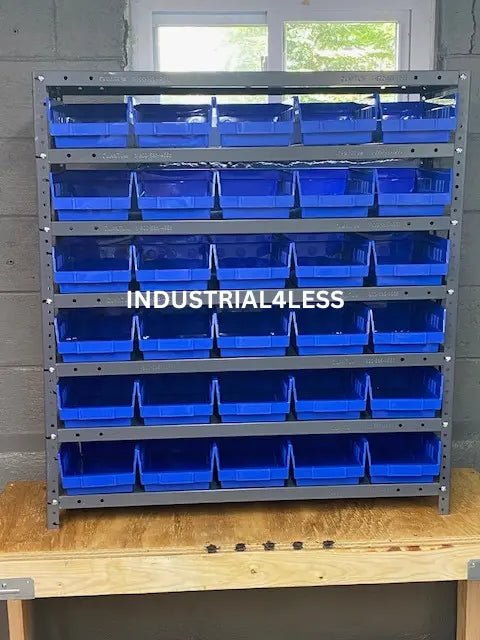When it comes to organizing small parts and hardware efficiently, one solution stands out as a game-changer: shelf bin organizers. These industrial strength shelving units paired with plastic open front bins provide the perfect combination of accessibility, durability, and customization. In this post we'll explore the world of shelf bin organizers, discussing their various features, options, and how to choose the right one for your specific needs.
Understanding Shelf Bin Organizers
Shelf bin organizers consist of two key components: industrial-strength shelving units combined with heavy-duty polypropylene open front plastic shelf bins. The shelves are available in galvanized steel or metal wire, both providing a robust option suitable for commercial and industrial environments. Deciding between galvanized steel and metal wire shelving depends on your specific needs and environment. For example, epoxy coated metal wire shelving is ideal for use in moist or humid conditions due to its rust-proof properties, making it suitable for walk-in coolers or freezers.
The shelves come in various depths, widths, and heights, allowing you to find the perfect fit for your space. The shelf depths are predetermined to match the depths of the bins, ensuring you maximize every inch of storage space. For instance, if you choose 18" deep shelves, you'll find pre-configured 18" deep shelf bin organizers with bins that perfectly complement them.
Features of Plastic Shelf Bins
The core of any shelf bin organizer is the plastic storage bins that sit on the shelves. These bins are designed to keep parts and inventory organized, labeled, and easily accessible. Here are the key features:
- Material: Plastic shelf bins are durable and resistant to corrosion, ensuring long-term protection for your stored items. This eliminates the need for frequent replacements, unlike cardboard or corrugated boxes.
- Optional Dividers: Plastic shelf bins are designed with divider slots, allowing you to create custom compartments within each bin for efficient categorization and separation of hardware.
- Labels: Most shelf bins feature slots or areas for labels, helping you quickly identify the contents and enhance organization.
- Stackable and Nestable: Depending on your application, you can choose stackable bins to maximize vertical space or nestable bins to save space when not in use.
Choosing the Right Shelf Bin Organizer
Now that you understand the components of shelf bin organizers, let's discuss the factors to consider when selecting the right one for your needs:
- Size: Determine the available space in your warehouse or shop and choose shelving units and bins that maximize every area. Consider the size of the items you need to store and whether each item requires its own bin or can be subdivided.
- Weight Capacity: Ensure the shelving unit and bins can support the weight of your hardware. Industrial-strength shelving typically handles heavy loads.
- Bin Quantity and Layout: Decide on the number of bins you need and how to arrange them. Plan for future expansion if necessary.
- Dividers and Labels: Choose bins with dividers and labeling options for precise organization.
- Accessibility and Workflow: Consider how frequently you'll need access to the items in the bins. Think about bin placement, accessibility, and ergonomics to enhance workflow.
- Space Availability: Assess your available space and choose a shelving unit and bin configuration that fits comfortably.
- Location of Use: Identify the environment where the shelving will be used. For instance, epoxy-coated metal wire shelving is suitable for moist or humid environments like walk-in coolers or freezers because of its rust-proof properties. Understanding the setting will help you choose the most appropriate shelving type.
- Durability and Longevity: Opt for high-quality materials and construction to ensure your organizer lasts for years.
- Budget: Set a budget and look for options that meet your requirements without exceeding your financial constraints.
Conclusion
Shelf bin organizers are a versatile and practical solution for efficiently organizing small parts and hardware. With various shelving options and plastic bin features, you can customize your organizer to meet your specific needs. By considering factors like size, weight capacity, layout, location of use, and budget, you can confidently choose the right organizer to enhance your workspace's efficiency and organization.
Investing in a quality shelf bin organizer is not just about tidiness; it's about saving time, reducing frustration, and boosting productivity in your workshop, garage, or warehouse. Start your journey towards a more organized workspace today!




